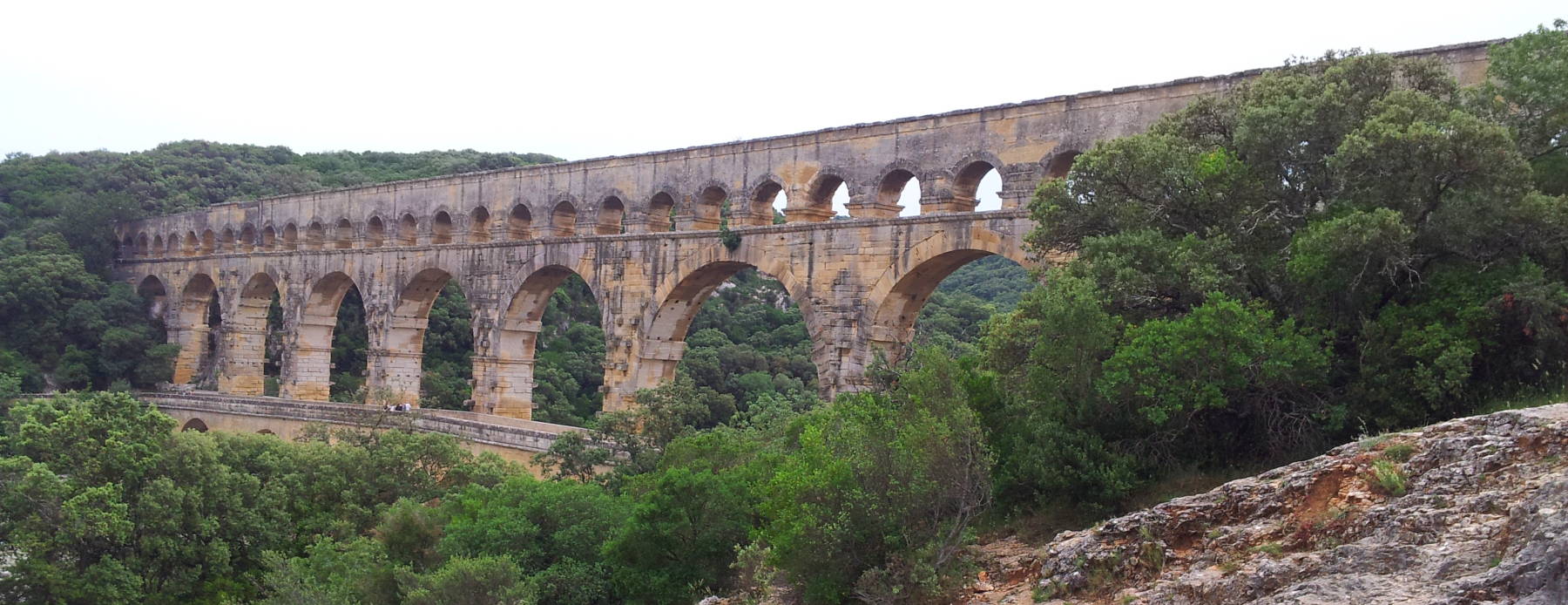
Pont du gard
Pont du Gard
Visiting Avignon Avignon Papacy Châteauneuf-du-PapeWe're visiting Avignon. We've seen the Palais des Papes in the old city, and taken a day trip to Châteauneuf-du-Pape. Now we'll continue to the northwest, to Pont du Gard, a large Roman aqueduct bridge that's the fifth-most-visited sight in France.
The Roman colony of Nemausus was founded before 28 BC. We now call the city Nîmes. It became the capital of the Narbonne province. In the age of Augustus (27 BC – 14 AD) it had a population of about 60,000 people.
All these people needed water. There was a large spring, the Fontaine d'Eure, about 20 kilometers away in a straight line. But the Garrigues de Nîmes, the southernmost foothills of the Massif Central, were in the way. A tunnel through them would have to be 8 to 10 kilometers long.
The only practical route was a 50-kilometer-long loop to the east around those foothills. The spring was only 17 meters higher than the repartition basin in Nemausus. But, with a very carefully designed and built aqueduct, this would work.
The average gradient would be about 1 in 2,900, but that would be for a constant gradient. The aqueduct would have to cross the Gardon river, and a constant gradient would make that crossing inconveniently high.
The Romans designed an aqueduct with a relatively steep gradient of 1:1493 or 0.67 meters per kilometer from the spring to the river crossing. It could then cross the river on an aqueduct bridge almost 50 meters above the river. This was unusually high compared to other Roman projects, but still a reasonable project. The rest of the way to Nemausus, the aqueduct would drop at the shallow rate of 1:4167, or just 6 meters over the remaining 25 kilometers. For one section, the descent was down to just 1:14,286, or 7 millimeters per 100 meters.
The resulting design made the aqueduct bridge 360 meters long, 48.8 meters above the mean water level in the river. The water course drops just 2.5 centimeters along its length, a gradient of just 1 in 18,241.
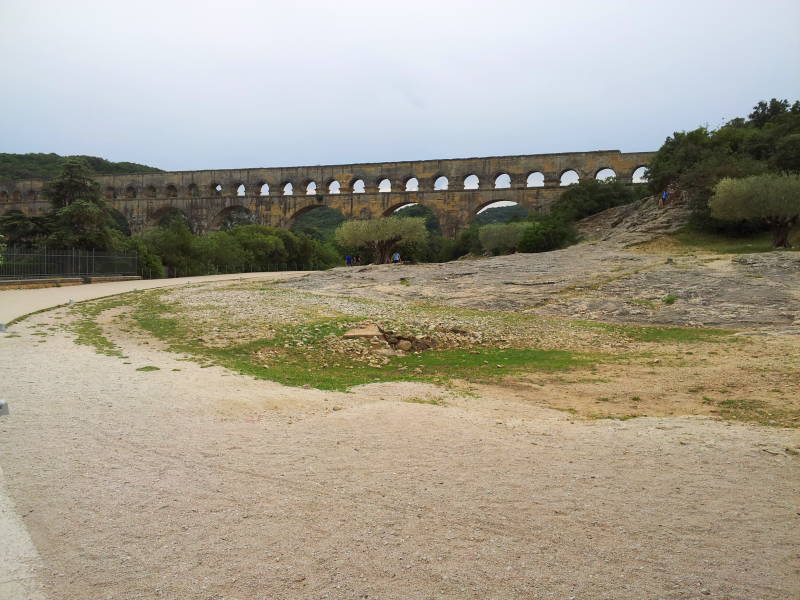
The system supplied about 40,000 cubic meters of water per day to the city. The water took about 27 hours to flow from the spring to the city, where it arrived at the castellum divisorum. This was a shallow, open basin about 5.5 meters in diameter and 1 meter deep. From there it flowed on into the city's main water pipes and supplied drinking water, the baths, and fountains.
The spring water was rich in dissolved calcium carbonate or CaCO3 which had leached out of the surrounding limestone. The calcium carbonate precipitated out of the water along the way, producing deposits in the aqueduct.
Also, vegetation grew in through the stone lid covering the channel along most of its route. The vegetation obstructed the flow of water. It also introduced algae and bacteria that decomposed through biolithogenesis, producing mineral concretions in the aqueduct.
The circitores were workers who crawled through the aqueduct as they cleaned it, scrubbing the floor and walls to remove vegetation and deposits.
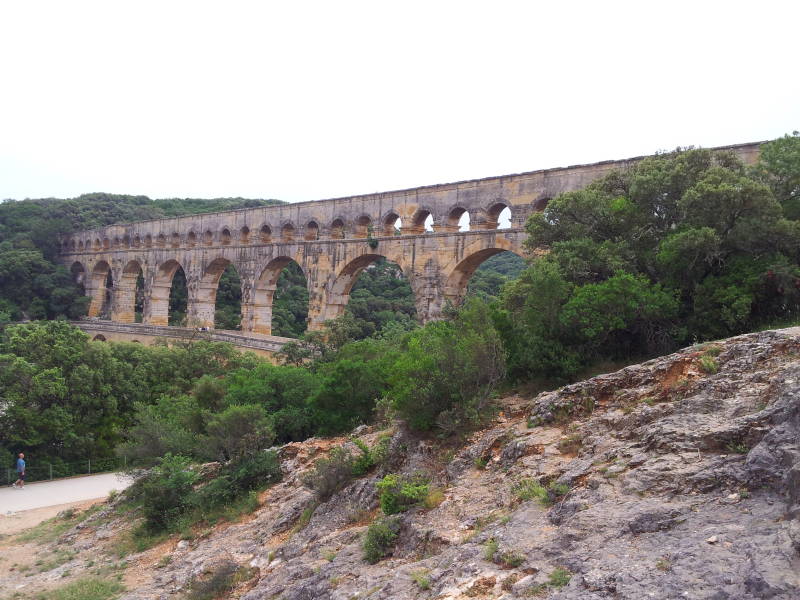
Historians and civil engineers today estimate that it would have taken about 15 years to build the Pont du Gard using 800 to 1,000 workers. It's now thought that it was built between 40 and 60 AD.
Waves of invaders started passing through in the 4th century. The aqueduct system was largely abandoned. As long as it supplied water, the water was used. But there was no more maintenance. The aqueduct started to clog with minerals and vegetation. Now up to 50 cm of deposits are on its walls and floor.
It probably went out of use in the 6th century, although sections may have remained somewhat useful as late as the 9th century.
In the 13th century the King of France granted the right to charge a crossing toll to the seigneurs of Uzès. That right later passed to the bishop.
An adjacent road bridge was added in the 18th century. You can see people walking along it in the picture below.
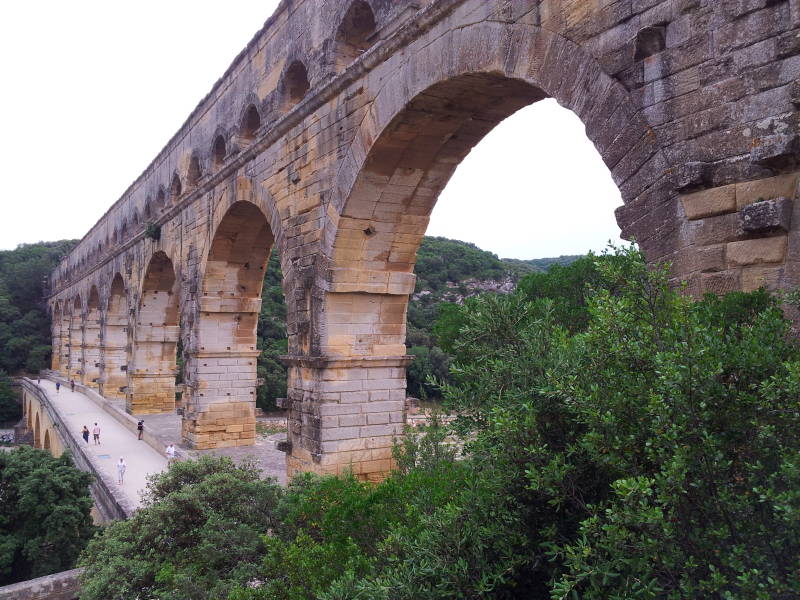
The aqueduct bridge was mostly constructed without either mortar or clamps. The blocks were cut to fit together and stay in place with friction alone. Most of the blocks were cut from the nearby quarry of Estel, about 700 meters downstream. Many blocks were numbered and labeled with instructions like fronte sinistra and fronte dextra for the workers assembling the bridge.
The end shows where a staircase was added in the 19th century to allow people to access the aqueduct channel.


The exterior is rough, but the aqueduct interior was cut as smooth as practical. The walls were dressed stone, with concrete on the floor. The floor and walls were coated with stucco containing ground pottery and tile. They were then painted with maltha, a mixture of lime, pork grease, and fig juice, producing a smooth and fairly durable surface.
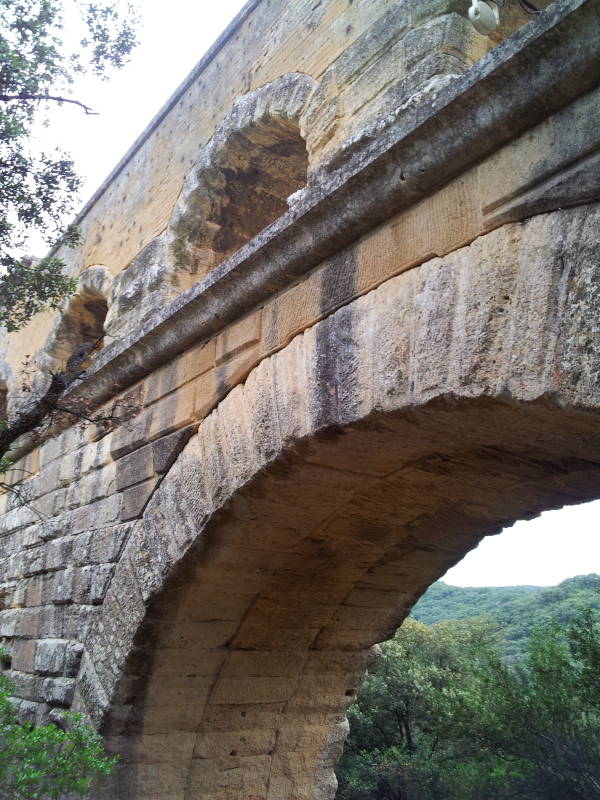
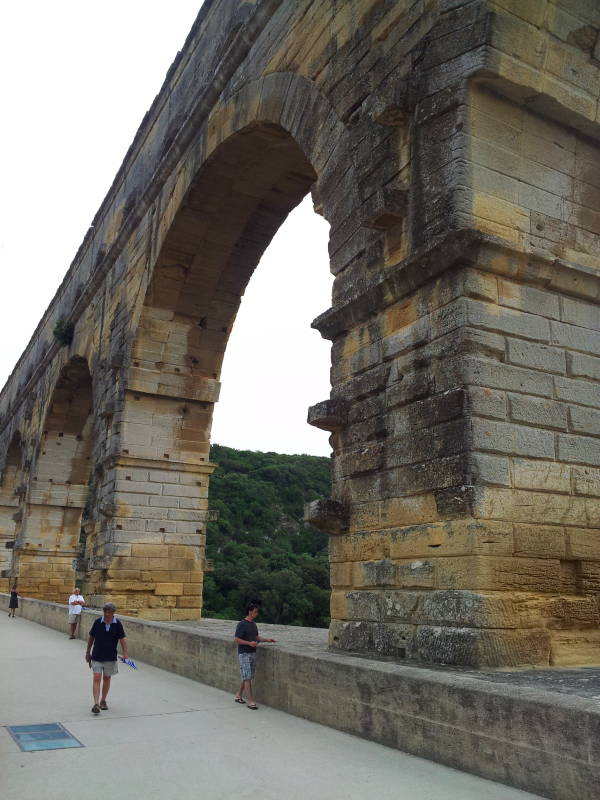
"Grand Tour"
The Pont du Gard has attracted visitors for centuries. It became a standard stop for apprentice masons. Starting in the 18th century, it became a stop for travelers on the Grand Tour.
It also became a potent symbol for French royalty looking for a visible connection to Imperial Roman power.
And, just regular visitors like us. Today it's the 5th-most-visited tourist spot in France.
South to Marseille, North to Paris
MarseilleNow it's time to leave Avignon. Marseille is just over 30 minutes away by TGV, and it's only two hours and 40 minutes to Paris. Here's a ticket to Paris, just 2:42 end to end. Notice which car (voiture) and place. You'll need the car number to know where to stand on the platform to board during the brief station stop.

The Gare d'Avignon TGV was completed in 2001. It looks more like an airport than your typical train station.
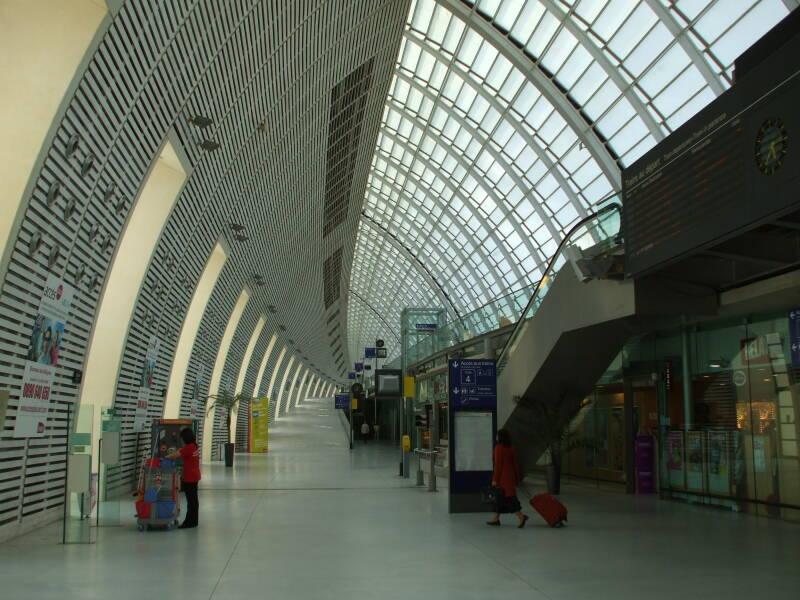
There's our train at the top of the schedule. A l'heure (or "on time"), of course, and on track #4.
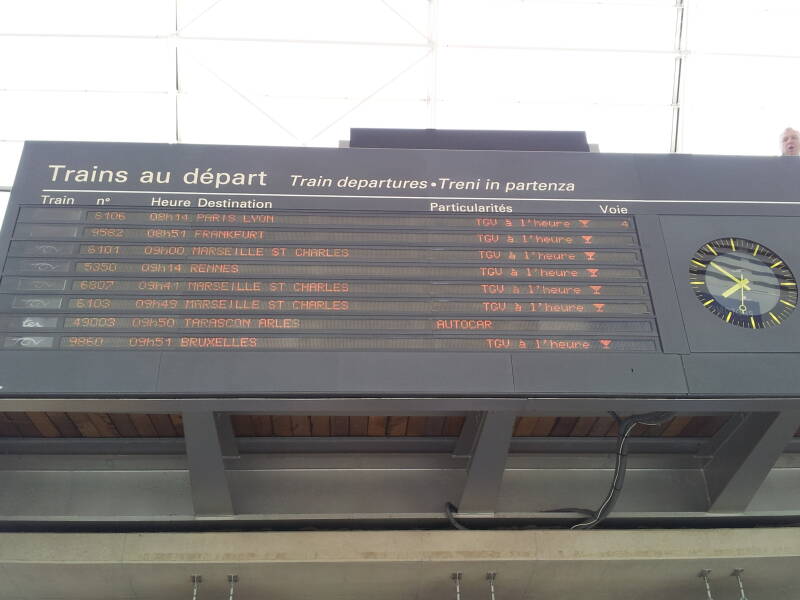
As we head toward the platform, look at the train composition diagram. We're in voiture #3, so we want to stand between V and W on the platform.

Here it comes! This train is running from Marseille to the Gare de Lyon station in Paris. The station stops are brief, make sure you're ready to board.
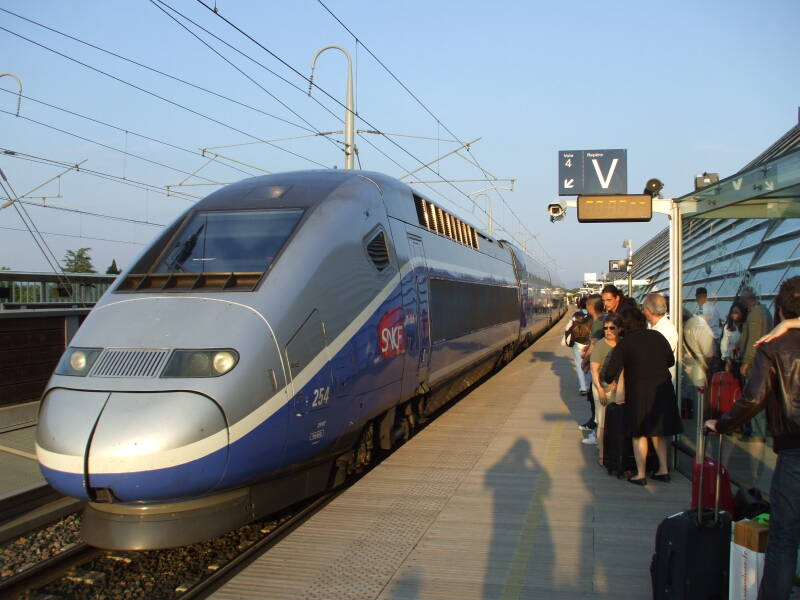
In less than 3 hours we're in Paris, at Gare de Lyon. The schedule board shows the many frequent onward departure times.

Continue visiting Avignon:
Or, somewhere else in France:

